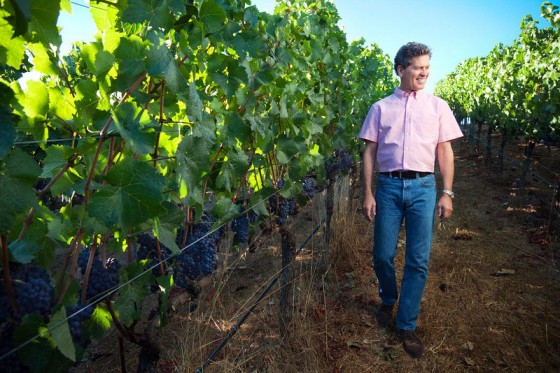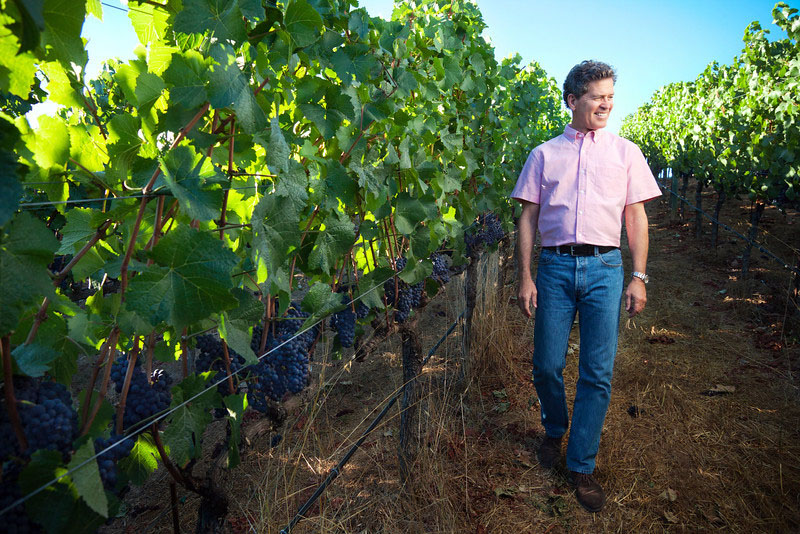
The Finger Lakes region has been abuzz with news that consulting winemaker Paul Hobbs is launching a project on the southeast side of Seneca Lake. Just as importantly, Hobbs is partnering with a German winemaker of high pedigree. Hobbs and the unconfirmed partner have chosen not to reveal that partner’s name yet, but more than a dozen Finger Lakes industry professionals tell NYCR that the partner will be Johannes Selbach of Selbach-Oster. An email to Selbach has not received a reply; official word will come on Michael Warren Thomas’Savor Life radio show later this month.
Hobbs is a high-wattage industry professional known for his work around the world, and particularly in California. He makes wine in a winery under his own name in Napa, and also makes California wine under his Crossbarn Winery label. His Vina Cobos produces malbec and other varieties in Argentina, and Hobbs also runs an importing outfit.
So why the Finger Lakes? Hobbs is from the Niagara region, and told The Drinks Business:
“We are starting from scratch, and we are preparing the land now,” he recorded, adding that he spent three years surveying the area before finding this site.
Speaking of the style of wine he plans to make with the help of his German partner, Hobbs said he would make an off-dry riesling.
“We will definitely make some wine in the Mosel style,” he admitted, adding, “but we will be trying dry Riesling too.”
It won’t happen right away. Various reports have the Hobbs property – just north of Watkins Glen – as being more than 60 acres, and the first step was clearing the land. It will take several years before the vines can bear wine-worthy fruit.
While NYCR is still waiting for Selbach to confirm his participation, consider what he’s said in the past about the Finger Lakes region. In an interview in 2008, Selbach was asked about wine regions outside Germany that produce great riesling. Regarding the United States, Selbach said, “ I do want to point a finger to a region whose rieslings I have been following since the early eighties and that is the Finger Lakes in upstate New York. Great potential there, never understood why they weren’t known by a larger crowd.”
The entire interview is worth reading. Selbach praised using older oak in riesling, saying, “Large casks of old oak – wonderful. They permit the wines to exhale some of their fermentation aromas and also permit a tiny bit of oxidation, something that the nouveau winemakers have rediscovered and now artificially induce in their stainless steel tanks –in microboullage.”
Could that be a signal for how Selbach plans to make riesling in the Finger Lakes?
“I see this as a potential watershed moment,” said August Deimel, winemaker at Keuka Spring Vineyards on Keuka Lake. “Just as the arrival of Drouhin in Oregon or the partnering of Mouton with Mondavi in Napa marked the arrival of those regions on the global wine scene, this could well have a similar effect. Hobbs and Selbach providing the imprimatur of California and Germany at once could have a powerful effect. It will undoubtedly cause some people to rethink their view of our region’s potential.”
That optimism was shared by many Finger Lakes winemakers, growers, and owners who spoke to NYCR.
“One might consider the same issues as they related to producers such as Zonin moving into Virginia (Barboursville) in the mid 70s, the Ferrers in Carnaros (Gloria Ferrer) in the early 80s or Herbert Konzelmann (and others) in Niagara in the mid 80s,” writes Bob Madill, Wine Director at Red Newt Cellars and a longtime partner at Sheldrake Point. “Hobbs and Selbach-Oster come to the Finger Lakes as complete wine business enterprises looking for growth. Their knowledge, experience and success span the integrated production duality of vineyards and cellar with the business acumen (and organizations) to achieve sales and distribution. Since both come with impeccable international business credentials I doubt that their primary objective is to open a tasting room on Seneca Lake. This is a welcome addition to Finger Lakes wine growing culture.”
Morten Hallgren, owner and winemaker at Ravines Wine Cellars, saluted the project while cautioning that doors are already opening for Finger Lakes producers. “I think we should all welcome Paul Hobbs and Johannes Selbach with open arms,” Hallgren said. “Anything that brings attention to the Finger Lakes at the national or international level is advantageous for all of us. While there will be an impact, I do not believe it will be anything like it would have been five or ten years ago. By now, the various markets around the country are wide open for Finger Lakes wines.”
“Whatever helps to bring more name recognition and potential quality to the Finger lakes region is a plus,” said Lou Damiani, owner and winemaker at Damiani Wine Cellars, just a few miles from the Hobbs project. “Big names, good winemakers help to keep raising the bar.”
On the subject of raising that proverbial bar, Deimel said that the Hobbs wines will demand better winemaking across the region. “Having to compete with a winery operating at global standards in our own backyard may be a kick in the pants,” Deimel explained. “We will need to raise our game if we don’t want to be left in the dust. From the moment this project releases a wine we will all have our marching orders: make something better than they did. And when we do, I think the wine world will be that much more inclined to take notice.”
Hobbs arrives with a history of battling environmental advocates near some of his projects. The more shrill criticism is hard to take seriously; for example, read this piece as an editorial, not as news, and you’ll see how things can be skewed.
But the fact remains that at Hobbs’ most recent project, the conversion of an apple orchard into a vineyard in Sebastopol, California, the local county shut down the project. Here’s the Press Democrat newspaper’s explanation:
A group of about 50 protesters angry at what they say is an environmentally damaging vineyard conversion project demonstrated in front of Paul Hobbs Winery in Sebastopol on Monday.
Known as the Apple Roots Group, its members want the permit revoked for Hobbs’ Watertrough Road property, where work began last month to convert the 48-acre apple orchard into a vineyard.
A week later, the county shut down the project because workers illegally removed creek-side vegetation and failed to prevent erosion.
You can read the full article here.
Privately, several Finger Lakes winery owners expressed concern about Hobbs’ environmental track record, but declined to comment on record. They told NYCR that they worry Hobbs’ problems with erosion in California could be replicated on his new land near Seneca Lake.
Still unknown is the potential Hobbs effect on prices: both regarding land value and grapes. Could a successful Hobbs project drive up the price of riesling grapes, impacting smaller wineries that purchase fruit? It’s possible, with the concomitant effect of higher prices for consumers. Finger Lakes acreage has always been remarkably cheap vis a vis other wine regions, and that could begin to change, too. But it’s way too early to conclude that any such changes are likely.
“In this case it’s hard to find any fault with the spotlight (the Hobbs project) is drawing to the Finger Lakes,” said Kelby Russell, winemaker at Red Newt Cellars. “They are not claiming that Paul Hobbs is coming to save the Finger Lakes, nor are they disparaging what the region is currently. Rather, I think the point is that the Finger Lakes has proven itself enough that anyone overlooking us would be foolish.”
“It is very exciting to have another committed riesling producer added to the set of Finger Lakes wineries,” said Dave Whiting, owner of Red Newt Cellars. “ I look forward to having them as neighbors.”
Ian Barry, winemaker at Villa Bellangelo and owner of his own small label Barry Family Cellars, offered optimism and caution.
“In the ten years since I’ve been in the Finger Lakes, we’ve come a long way in building the reputation of our wines,” he said. “Having producers with international holdings and great reputations interested in the Finger Lakes will certainly raise the profile further.”
But Barry wonders about some of the other effects of the project.
“The worry I have is that as this tide rises along with the profile of the Finger Lakes, there will be other investors who follow suit, driving up the cost of land and the cost of doing business here,” he said. “One thing that has always been appealing about the Finger Lakes to me, as a person of modest means but passionate about making wine, is that it’s possible to do business here and to have the audacity to dream of one day having my own brand. That culture could change with broader notoriety.”
Thomas, who has talked about the possibility of a Paul Hobbs Finger Lakes project since 2011, offered a take that might bolster some of Barry’s concerns.
“This is the tipping point for the Finger Lakes on the world stage,” Thomas said. “With land at $6,000 per acre, exponentially less than other key regions of the US, I believe there will be a land rush, as investors hurry to lock in vineyards and wineries within a few miles of one of the hottest and best winemakers in the world, and within a day’s drive of 60 million people.”
What also is not clear at this point is what local winemaking talent may be hired for this project. It is unlikely that Selbach will move to and live in the Finger Lakes. Will this new venture follow the Forge Cellars model, where the big-name co-owner/winemaker (Louis Barruol) visits a few times per year, with a local winemaker (Justin Boyette) handling day-to-day duties? We just don’t know yet.
The New York Cork Report has inquired with Hobbs about an interview and will report what we hear.

